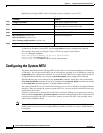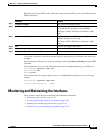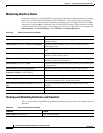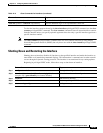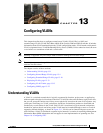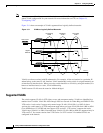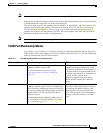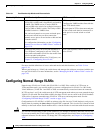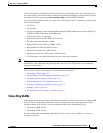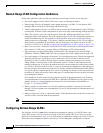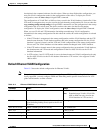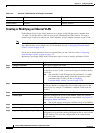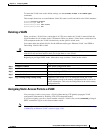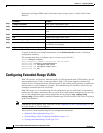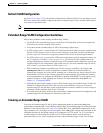
13-4
Catalyst 2960 and 2960-S Switch Software Configuration Guide
OL-8603-09
Chapter 13 Configuring VLANs
Configuring Normal-Range VLANs
For more detailed definitions of access and trunk modes and their functions, see Table 13-4 on
page 13-14.
When a port belongs to a VLAN, the switch learns and manages the addresses associated with the port
on a per-VLAN basis. For more information, see the “Managing the MAC Address Table” section on
page 5-20.
Configuring Normal-Range VLANs
Normal-range VLANs are VLANs with VLAN IDs 1 to 1005. If the switch is in VTP server or
VTP transparent mode, you can add, modify or remove configurations for VLANs 2 to 1001 in the
VLAN database. (VLAN IDs 1 and 1002 to 1005 are automatically created and cannot be removed.)
In VTP versions 1 and 2, the switch must be in VTP transparent mode when you create extended-range
VLANs (VLANs with IDs from 1006 to 4094), but these VLANs are not saved in the VLAN database.
VTP version 3 supports extended-range VLANs in VTP server and transparent mode. See the
“Configuring Extended-Range VLANs” section on page 13-10.
Configurations for VLAN IDs 1 to 1005 are written to the file vlan.dat (VLAN database), and you can
display them by entering the show vlan privileged EXEC command. The vlan.dat file is stored in flash
memory on the stack master. Stack members have a vlan.dat file that is consistent with the stack master.
Caution You can cause inconsistency in the VLAN database if you attempt to manually delete the vlan.dat file.
If you want to modify the VLAN configuration, use the commands described in these sections and in the
command reference for this release. To change the VTP configuration, see Chapter 14, “Configuring
VTP.”
Dynamic access A dynamic-access port can belong to one VLAN
(VLAN ID 1 to 4094) and is dynamically assigned by
a VMPS. The VMPS can be a Catalyst 5000 or
Catalyst 6500 series switch, for example, but never a
Catalyst 2960 or 2960-S switch. The Catalyst 2960
or 2960-S switch is a VMPS client.
You can have dynamic-access ports and trunk ports
on the same switch, but you must connect the
dynamic-access port to an end station or hub and not
to another switch.
For configuration information, see the “Configuring
Dynamic-Access Ports on VMPS Clients” section on
page 13-25.
VTP is required.
Configure the VMPS and the client with the
same VTP domain name.
To participate in VTP, at least one trunk port
on the switch stack must be connected to a
trunk port of a second switch or switch
stack.
Voice VLAN A voice VLAN port is an access port attached to a
Cisco IP Phone, configured to use one VLAN for
voice traffic and another VLAN for data traffic from
a device attached to the phone.
For more information about voice VLAN ports, see
Chapter 15, “Configuring Voice VLAN.”
VTP is not required; it has no effect on a
voice VLAN.
Table 13-1 Port Membership Modes and Characteristics
Membership Mode VLAN Membership Characteristics VTP Characteristics



